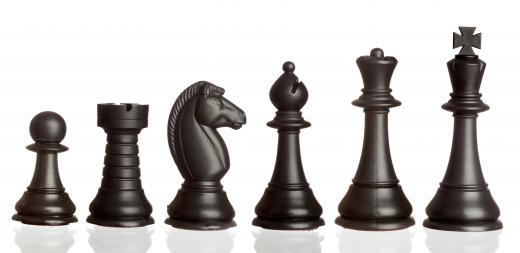At WiseGEEK, we're committed to delivering accurate, trustworthy information. Our expert-authored content is rigorously fact-checked and sourced from credible authorities. Discover how we uphold the highest standards in providing you with reliable knowledge.
What Was the Turk?
The Turk was a chess-playing machine created by German inventor Wolfgang von Kempelen in 1770 and exhibited for 84 years. The machine could execute elaborate puzzles and strategies and played a strong game of chess against human opponents, winning the great majority. The Turk was destroyed by fire in 1854 and revealed as a hoax in a series of magazine articles in The Chess Monthly three years later.
Von Kempelen's machine consisted of the life-sized upper torso of a man in Turkish costume behind a large cabinet with a chess board on top. The cabinet had many doors, which opened to reveal a complicated array of clockwork-like gears and a clear view through the cabinet. The machine also came with a small coffin-shaped box that Von Kempelen would place on top of the cabinet and peer into mysteriously, suggesting that it had some supernatural power over the workings of the machine.

The Turk nodded twice when the opponent's queen was threatened, and three times when the king was placed in check. If the opponent made an illegal move, the machine would shake its head, return the incorrectly moved piece, and take its next turn. In its later years, the machine was equipped with a voice box, allowing it to say Échec! (French for "check"). In addition to playing chess, the Turk could also communicate via a letter board to answer questions from spectators.

Though the Turk was exhibited as an automaton, an early type of robot, The Chess Monthly articles exposed it as a machine run by a human operator hidden inside the box. Many aspects of the machine were designed to mislead observers. For example, there was a clockwork-like sound every time the Turk moved.
The Turk was equipped with a sliding seat so that the operator could evade discovery as the cabinet's doors were opened in turn. The chessboard on the top of the cabinet was thin, and the chess pieces were magnetic, allowing the operator to see each move as corresponding magnets inside the machine were attracted to the active squares. The operator controlled the Turk with a pegboard chessboard that caused the Turk's left arm to move over the chessboard on top of the cabinet. With a dial, the operator could open and close the Turk's hand over the chess pieces, and further machinery controlled the Turk's facial expressions. There were also two brass disks, one inside and one outside the machine, that allowed the operator and the presenter to communicate.
The Turk was first created and exhibited at Schönbrunn Palace for the Austrian Empress Maria Theresa. In 1783, von Kempelen took the machine on a European tour beginning in Paris, where Benjamin Franklin played a match against it. Von Kempelen died in 1804, and his son sold the machine three years later to musician Johann Nepomuk Mälzel, who improved upon the machine and exhibited it until his death in 1838. Shortly after Mälzel acquired the machine, Napoleon paid a visit to Schönbrunn Palace to try his luck against it.
Mälzel toured the Turk in Italy, France, and the entire United Kingdom before debuting it in America in 1826. He also exhibited the machine in Cuba. In 1838, he died at sea, leaving the Turk with the ship's captain. Once back in Europe, the machine changed hands a few times, eventually ending up in the Peale Museum in Baltimore, Maryland, USA. It was destroyed in a fire on 5 July 1854.
John Gaughan, a Los Angeles manufacturer of magicians' equipment, began building a reconstruction of the original Turk, using the original chessboard, in 1984. It took him five years to complete, and it was first exhibited in November 1989. Gaughan's version differs from the original Turk in that it is controlled by a computer.
AS FEATURED ON:
AS FEATURED ON:












Discuss this Article
Post your comments